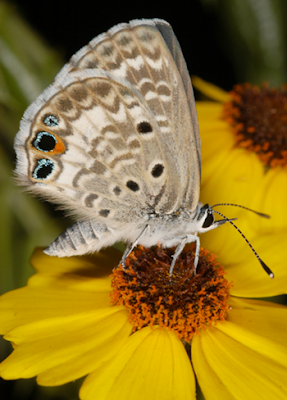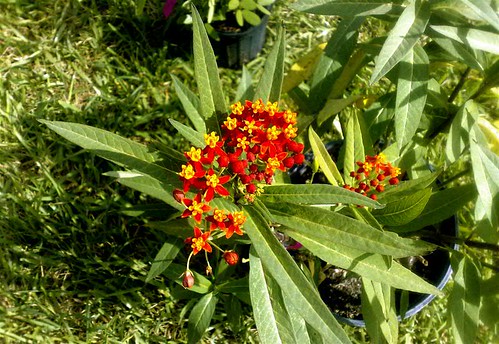update Aug 4: a new Miami Blue butterfly photo added below, courtesy of Jaret C. Daniels.
I didn't volunteer this week because Jon-Mario was going to be out on Friday and my car had to go to the shop. But I did stop by for a few hours on Saturday to see what I could learn during Butterfly Days, a two-day event dedicated to these beautiful creatures and the gardening that supports them.
I really don't know a heck of a lot about butterflies, but it seems like for those who are into it, there's quite a bit to learn. Many years ago, I lived in a cottage with a beautiful garden. I planted a passion flower vine that promptly became the nourishment of many caterpillars. I observed the process from beginning to end -- as they gobbled up the plant and then formed a chrysalis. One morning, all of the butterflies had burst out and were flying around me. It was a very special moment and one I'll not soon forget.
I caught two lectures on Saturday. If there's one thing I learned, it's that butterfly gardening requires balance. If you simply want to attract adult butterflies, plant nectar host plants so that they can feed. But if you want to support the entire lifecycle, also plant larval hosts so that females can lay eggs and caterpillars can eat. Maintaining the right number of plants seems to be the key ... and part of the fun!
BUTTERFLY GARDEN BASICS
Cindy David, a very entertaining and enthusiastic lecturer from the Florida Chapter of North American Butterfly Association, talked about Butterfly Gardens 101. She said something that stuck in my mind: "Butterflies are flying flowers." I had never thought of them that way, but it's true -- their delicate wings are like moving petals.
Here are some of Cindy's recommendations for host plants to attract many different kinds of butterflies:
- monarch and queen - milkweed
- julia, fritillary and zebra - passion vine varieties (passiflora), including Florida native, Corky Stem (passiflora suberosa)
- atala - coontie
- sulphur - cassia and senna
- east black swallowtail - dill, parsley and fennel
- swallowtail - wild lime (as a substitute for citrus)
Again, it's all about balance.
And speaking of, the great thing about butterfly gardening is that it requires the use of native plants, which means your garden can support the local ecosystem. Some of the plants, like Firebush (hamelia patens), also attract hummingbirds to their nectar and other avian species to their seeds. You can learn more about gardening with native plants from the Dade Chapter of the Florida Native Plant Society.
THE MIAMI BLUE
My favorite part of Butterfly Days was learning about a rare and fascinating little creature -- no bigger than a nickel -- called the Miami Blue. This native Florida butterfly used to thrive on the east and west coasts of Florida, as well as the Keys and the Dry Tortugas. Urban development and mosquito spraying, as well as the devastating impact of Hurricane Andrew in 1992, led to declining populations. At one point, many scientists believed the Miami Blue was extinct. It wasn't until 1999 that a butterfly enthusiast spotted Miami Blue at Bahia Honda State Park.
Jaret C. Daniels, Ph.D. of the University of Florida gave a lecture about the Miami Blue. Jaret is an Assistant Professor of Entomology and Nematology at the university's Institute of Food and Agricultural Sciences. He also leads a Miami Blue captive propagation program at the McGuire Center for Lepidoptera Research in Gainesville.
 A female Miami Blue is not as blue as her male counterpart. What distinguishes Miami Blue from similar butterflies is the white band underneath the black and blue spots. Photo courtesy of Jaret C. Daniels.
A female Miami Blue is not as blue as her male counterpart. What distinguishes Miami Blue from similar butterflies is the white band underneath the black and blue spots. Photo courtesy of Jaret C. Daniels.Here are some notes from the lecture:
- The Miami Blue population at Bahia Honda likes living near the beach and it feeds on Gray Nickerbean (Caesalpinia bonduc).
- Miami Blue larvae have a symbiotic relationship with ants. Larvae secrete a sugary substance from special organs on their backs, which ants consume. In return, ants protect larvae from predators and parasites.
- Hurricane Andrew had a devastating impact on the already declining population of Miami Blues. The hurricane season of '05 also affected populations. The loss of coastal habitat during a storm is the main culprit.
- The captive propagation program has produced over 30,000 viable organisms since 2003. A Q-tip, soaked in Gatorade as a substitute for nectar, feeds the adults. Between 2004-07, about 5,000 butterflies were introduced into the environment.
- In 2006, a population of Miami Blues was discovered at Boca Grande Key (Key West National Wildlife Refuge).
- The best place to spot the Miami Blue and many other butterflies is Bahia Honda State Park.
TOUR THE GARDEN
Here is an impromptu video I shot on my cellphone of the butterfly garden this weekend. Enjoy! Click through to YouTube so you can see the video in high-quality mode and also read my annotations.









1 comment:
thanks for the tour of your imaginary other you and world and butterflies - where i lived in california Monterey and santa cruz the monarch butterflies would cover the whole tree and if i recall correctly they called them butterfly trees - as a kid i use to catch butterflies and fire flies too but the think i will leave you with is something you as a wordsmith will remember - original name for books in china was butterfly wings - people would write on butterfly wings - so put that into your imagination and fly oh yes also it is said that the flapping of butterfly wings can not only change the direction of a storm it can also create a storm - so keep flapping your wings
be you
g-oh
Post a Comment